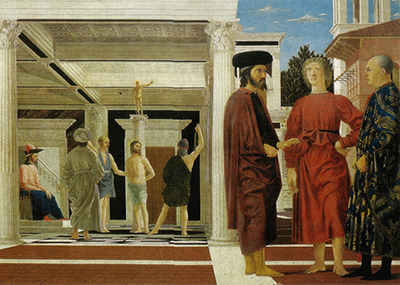Discover the life and career of Piero Della Francesca in this extensive biography.
Piero Della Francesca was born in a small town of Borgo San Sepolcro 149 miles north of Rome. His exact date of birth was never recorded, but it is estimated to be between 1410 and 1420. He schooled in his home town and specialized in mathematics.
Early career
Piero was inspired by Domenico Veneziano and Antonio di Giovanni Anghiari. Antonio was also responsible for apprenticing Piero, evidence of joint payments around 1430 proves the two artists were working together. In early 1430, Antonio was at the peak of his career as a painter and Piero was starting. Piero’s mastery of mathematics from schooling helped his in his paintings which were designed well with informed precisions and correlation of images and his pictures.
Piero started painting in his home town and then moved to Florence in mid-1430s where he continued painting; only that this time he built a career out of the painting. Piero’s record of his first payment was in 1437. In 1442, Piero returned to Borgo where he was nominated in the city council. The work in the city council didn't hinder him from traveling and painting in the areas close to Borgo. There is no evidence showing that Piero was ever married and this worked well for him since he could move and settle in distant cities with convenience.
Legend of the true cross
Piero Della Francesca undertook a project in Arezzo which came to be termed as his most ambitious project. This project of completing the series of paintings Basilica of San Francesco church is estimated to have taken him 14 years to complete. The work had been started by Bicci di Lorenzo who passed on before finishing the work.
The legend of the true cross contains thirteen sets of paintings. Piero changed the original sequence of painting and came up with his rearranged chronological sequence. He reversed the traditional left to right order by placing his first painting on the right with a reversed order. Pieros arrangement gives a new perspective of artistic knowledge in combination with geometrical knowledge. While this work is credited to Piero alone, it is unclear if he was working alone or if he outsourced some painters.
The main events depicted by the legend of the true cross are the prophets Isaiah and Jeremiah, torture of Judas the Jew, the unearthing of the true cross, the exaltation of the cross and the Annunciation of Mary among others. The legend of the true cross is considered the most exceptional work ever done by Piero Della Francesca. A combination of his mastery of color and geometrical symmetry makes his work outstanding.
Whipping of Christ
This masterpiece painting of the thrashing of Christ by Piero Della Francesca is estimated to have been made between 1455 and 1465. The art stands on a piece of wood measuring 58.4 by 81.5cm. The picture consists of two main parts which are the whipping which takes center stage in the painting and three men in the foreground. The image can be geometrically divided into two, separating the two events without watering down any of the representations.
From the main event in the painting, two well-built men are whipping Christ as the other two watches. The man seated is Pontius Pilate, and the other man who is seen from behind is speculated to be a high ranking official given his dressing. The men in the foreground are unidentified, but the man in the middle is an angel. The men seem to be unaware of the main event taking place in the background of the painting.
The interpretation of this painting has still contended until present. The picture can be divided to have two complete paintings; the main event of whipping and the vague foreground picture. The decoding of the image at the foreground still not concrete and this shows how Piero mastered the art of painting.
Retirement
Piero Della Francesca’ stopped painting at around 1478 when he settled in Rimini. He inspired painters of his time such as Luca Signorelli and Perugino who frequented his workshop after his retirement. Piero went blind in the late 1480s and passed on later in 12th October 1942. During his time, Piero was famous for mathematics since not many people had the chance to see his paintings. Most of his paintings were on church walls, and one had to travel to see them.
During his lifetime, Piero published three articles on algebra, mathematics and geometry. While some of his work got destroyed together with the walls where he painted, most of his work is well documented. In the 20th century, Piero came to be recognized as an icon painter of the 15th century. His works are well protected in famous museums in the world. Piero’s works have inspired many painters of the modern times. His paintings are outstanding in their consistent theme of serenity; a significant reason why churches chose him for paintings.




